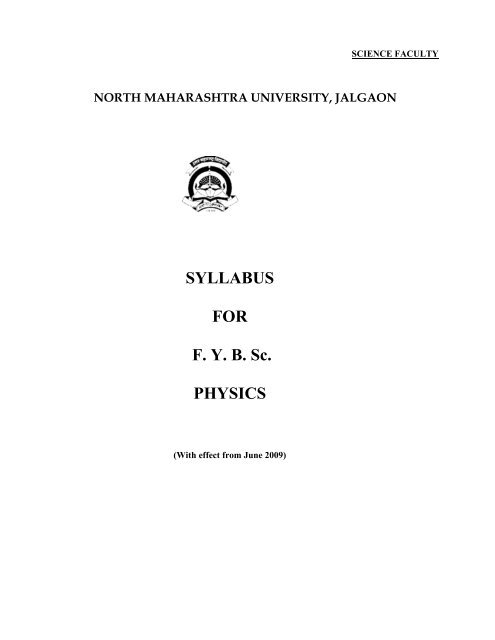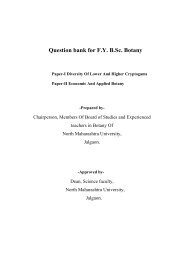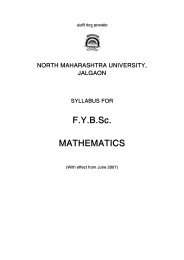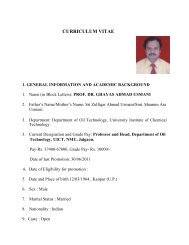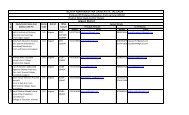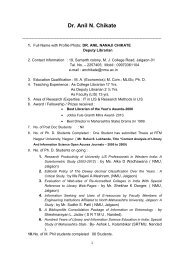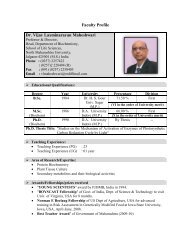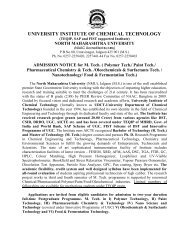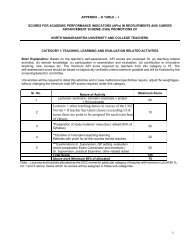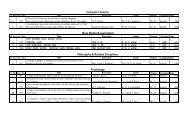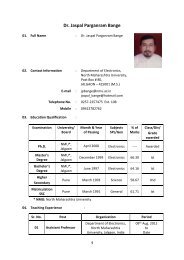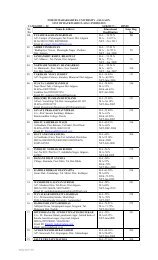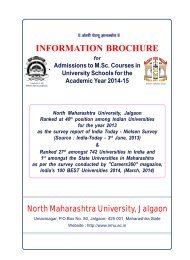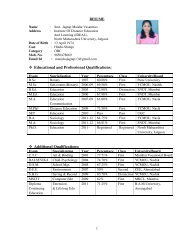SYLLABUS FOR F. Y. B. Sc. PHYSICS - North Maharashtra University
SYLLABUS FOR F. Y. B. Sc. PHYSICS - North Maharashtra University
SYLLABUS FOR F. Y. B. Sc. PHYSICS - North Maharashtra University
Create successful ePaper yourself
Turn your PDF publications into a flip-book with our unique Google optimized e-Paper software.
SCIENCE FACULTYNORTH MAHARASHTRA UNIVERSITY, JALGAON<strong>SYLLABUS</strong><strong>FOR</strong>F. Y. B. <strong>Sc</strong>.<strong>PHYSICS</strong>(With effect from June 2009)
SCIENCE FACULTYNORTH MAHARASHTRA UNIVERSITY, JALGAONClass: F. Y. B. <strong>Sc</strong>.Subject: PhysicsWith effect from June, 2009The Board of Studies in physics in it’s meeting held on 29 th April 2009 hasunanimously decided, the revision of syllabus in physics at F. Y. B. <strong>Sc</strong>. in view of Semesterpattern. The nomenclature accepted is as follows,PHY YSC [Y for year, S for semester and C for course number].The titles of the papers for F. Y. B. <strong>Sc</strong>. (Physics) are as given below;MarksCourse Title Semester PeriodsExt IntPHY 111: Mechanics and Properties of matter 1 40 40 10PHY 121: Heat and Thermodynamics 2 40 40 10PHY 112: Electricity and Magnetism 1 40 40 10PHY 122: Applied Physics 2 40 40 10PHY 103: Practical Course 1 and 2 80 80 20Note: The industrial tour is compulsory for students of F. Y. B. <strong>Sc</strong>. (Physics). The tour reportshould be submitted at the time of practical examination.
PHY 111 : Mechanics and Properties of matterUNIT-I: Pendulum(06 Periods, 06 Marks)Compound pendulum, it’s application as Kater’s pendulum, Torsional pendulum andBifilar pendulum.UNIT-II: Elasticity(08 Periods, 08 Marks)Elastic constants of isotropic solid and relation between them (with derivation),Bending moments, Cantilever, Beams supported at both ends.UNIT-III: Surface tension(10 Periods, 10 Marks)Surface tension, Surface energy, Angle of contact at liquid-solid interface, Wettingangle and wettablity; Relation between surface tension, excess pressure and radius ofcurvature; Factors affecting surface tension, Determination of surface tension by Jaeger’smethod; Applications of surface tension.UNIT-IV: Fluid dynamics(08 Periods, 08 Marks)General concept of fluid flow, Streamline and turbulent flow, Equation of continuity,Concept of pressure energy, Bernoulli’s equation and its applications to : venturimeter, pitottube, dynamic lift and thrust on a rocket.UNIT-V: Viscosity(08 Periods, 08 Marks)Viscous fluids, Flow of liquid through capillary tube, Poiseuille’s equation,Experimental determination of coefficient of viscosity of liquid by Poiseuille’s method, Effectof temperature and pressure on viscosity of liquid.(TOTAL: 40 Periods, 40Marks)REFERENCES:1. Physics: S. G. Starling (Longman and Green co. Ltd.)2. A Text book of properties of matter: N. S. Khare and S. Kumar (Atmaram andSons, New Delhi)3. Physics Course, Vol-1, Mechanics: E.M.Purcell , Ed.Berkeley ( McGraw-Hill)4. “The Feymman Lectures in Physics”, Vol-1: R.P.Feymman, R.B.Lighton and M. Sands(B.I. Publications, Bombay).5. General Properties of Matter : D. S. Mathur, (S. Chand Publications).6. Physics Vol.1 : D. Halliday and R. Resnik.
PHY 121 : Heat and thermodynamicsUNIT-I: Equation of state(08 Periods, 08 Marks)Andrew’s experiment and Amagat’s experiment : Discussion on experimental results,van der Wall’s equation, Critical constants, Reduced equation of state, Boyle’s temperature.UNIT-II: Thermodynamics(12 Periods, 12 Marks)Definitions of thermodynamic state, Adiabatic and isothermal changes, Indicatordiagram, Work done during adiabatic and isothermal changes, Thermodynamic equilibriumand its conditions, Zeroth law of thermodynamics, Concept of internal energy, 1 st law ofthermodynamics, internal energy as a state function, reversible and irreversible changes.UNIT-III: Second and third law of thermodynamics(10 Periods, 10 Marks)Carnot cycle and its efficiency, Carnot’s theorem, Second Law of thermodynamics,Otto engine and Diesel engine : their efficiencies, Concept of entropy, Principle of increase ofentropy, Entropy temperature diagram, Third law of thermodynamics.UNIT-IV: Applications of thermodynamics(10 Periods, 10 Marks)Joule-Thomson porous plug experiment, Joule’s expansion of ideal gas, ClausiusClapeyron latent heat equations, Principles of thermometry, thermocouple, Platinum resistancethermometer.(TOTAL: 40 Periods, 40 Marks)REFERENCES:1. Heat and Thermodynamics: V. N. Das2. Text book of Heat : D. K. Jha3. Heat and Thermodynamics: M. S. Yadav4. Text book of Thermodynamics : D. K. Jha5. Text book of Heat : J. B. Rajam6. Heat and Thermodynamics: Brijlal and Subramanyam7. Treatise on Heat : Saha and Srivastav8. Principle of Refrigerator : Roy J. Dossal
PHY 112 : Electricity and MagnetismUNIT-I: Current Electricity(12 Periods, 12 Marks)Kirchhoff’s laws, Loop analysis by Kirchhoff’s laws, Thevenin’s theorem and Norton’stheorem with illustrations, Maximum power transfer theorem (D. C source for all theorems),Current density vector, Power Consumption and Joule’s law.UNIT-II: Electrical D. C. Circuits(08 Periods, 08 Marks)Growth and decay of currents in a circuit containing inductance and resistance, Charging anddischarging of a condenser through a resistor, Concept of time constant.UNIT-III: Magnetic properties of materials(10 Periods, 10 Marks)Introduction, Magnetic parameters, Origin of magnetism, Classification of magneticmaterials, Basic features of magnetic materials, Soft and hard magnetic materials.UNIT-IV: Electromagnetic Induction(10 Periods, 10 Marks)Self induction, Mutual induction, Transformer: Principle, Relation between turns ratiowith current and voltage ratios; Efficiency of transformer, Losses in transformer, Types oftransformer.(TOTAL: 40 Periods, 40 Marks)REFERENCES:1. Foundation of Electromagnetic theory : John R. Reitz & Milford.2. Electricity and Magnetism : A. Kip3. Electricity and Magnetism : D. C. Tayal4. Principle’s of Electronics : V. K. Mehta5. Basic Electronics : B. L. Thereja6. Classical Electricity & Magnetism : Panofsky & Phillips7. Introduction to material science : H. B. Lal (Dominant publishers, New Delhi)8. Electricity and Magnetism : Pricillar W. laws(Willey).9. Text book of Electricity : D. K. Jha10. Text book of Magnetism : R. K. Verma
PHY 122: Applied PhysicsUNIT-I: Introduction to materials(08 Periods, 08 Marks)Phases of material:- solid, liquid, gases and plasma; Classification of materials:-metals, alloys, glasses, ceramics and polymers; Optical and electrical properties of materials.UNIT-II: Electromagnetic radiations in Communication (08 Periods, 08 Marks)Electromagnetic waves and their characteristics, Transverse nature of electromagneticwaves, Electromagnetic spectrum, Propagation of electromagnetic waves in the atmosphere,Troposphere, Stratosphere, Thermosphere (Ionosphere) propagation of radio waves, Groundwave propagation, Sky wave propagation, Space wave propagation.UNIT-III: Fiber Optics(08 Periods, 08 Marks)Introduction, Preparation of optical fiber, Optical fiber Materials, Principle of operationof optical fiber, Types of optical fiber, Losses in optical fiber, Concept of numerical aperture(NA), Advantages of optical fiber communication.UNIT-IV: Solar Energy(08 Periods, 08 Marks)Energy crisis and alternatives, Conventional and non Conventional energy sources,spectral distribution of solar radiation, pyranometer, Flat plate collector, solar water heater,solar cooker.UNIT-V: Introduction to Bioelectricity(08 Periods, 08 Marks)Electricity observed in living systems, examples & origin of Bio-electricity, Sodium &potassium transport & Nernst equation, Resting & action potential, conduction velocity.REFERENCES:(TOTAL: 40 Periods, 40 Marks)1. Principle of Instrumental Analysis (Fifth edition) : Skoog, Holler (Nieman SaundersCollege publishing).2. Modern Engineering Physics : A.S.Vasudevan (S.Chand).3. Solar Energy : S.P.Sukhatme (Tata MacGraw Hill)4. Solid state electronic devices (II Edition) : B.G.Streetman (Prentice Hall New Delhi).5. Introduction to Fiber Optics : Ajoy Ghatak . K. Thyagarajan (Cambridge Uni. Press).6. Elements Of Material <strong>Sc</strong>ience : Van Vlack7. Elements Of Material <strong>Sc</strong>ience : Raghvan : Prentice Hall of India New Delhi8. From Neuron to brain - Kuffer & Nicholas (Sinaur Asso.Inc.publication SunderlalMassachusettse).9. Biomedical Instrumentation and Measurements (II Edition) - L.Cromwell,F.J.Weibell, E.A.Pfeiffer (Pearson Education Singapore Pte,Ltd.).
PHY 103: Practical CourseNote: Students should perform at least eight experiments from each section.SECTION-I1. M. I. of a disc by torsional pendulum.2. η- by torsional oscillations.3. Ketar’s pendulum.4. Flat spiral spring (Determination of Y and η ).5. Y by bending.6. Y by vibrational cantilever.7. Viscosity by flow through a capillary tube.8. Poisson’s ratio of rubber by rubber cord method.9. Surface tension by Jaeger’s method10. Verification of Bernoulli’s theorem.11. Thermal conductivity by Lee’s method.12. Study of components of two/Four stroke engines.13. Frequency of a. c. using vibrating wire and magnet.14. Platinum resistance thermometer.15. Thermocouple as thermometer.SECTION-II1. Verification of Kirchhoff’s laws.2. Verification of Thevenin’s theorem.3. Verification of Norton’s theorem4. Maximum power transfer theorem.5. Charging and discharging of condenser through resistor.6. To determine efficiency and turns ratio of transformer.7. Hysterisis by solenoid.8. Use of analog multimeter.9. Electric billing with energy meter.10. R. I. of prism.11. Dispersive power of prism.12. Study of solar cell.13. Study of flat plate collector.14. Study of solar cooker.15. Study of fiber optics communication.References:1. College Practical Physics: Khanna and Gulati (S. Chand and Co. Ltd , Delhi)2. Practical Physics: Gupta and Kumar (Pragati Prakashan Meerat)3. Advanced Level Practical Physics: J. M.Nelkon,J.M.Ogloom (EIBS)4. Advanced Practical .Physics: Worsnop and Flint5. A Text book of practical Physics: Shrinivasan and Balasubranian6. A Text book of practical Physics: Indu Prakash and Ramkrishna.7. Practical Physics: R. K. Shukla and Anchal srivastava (New Age International)


